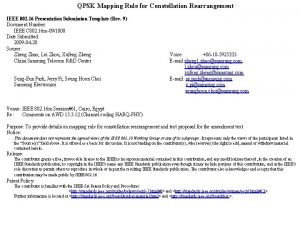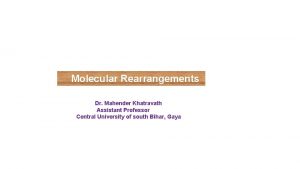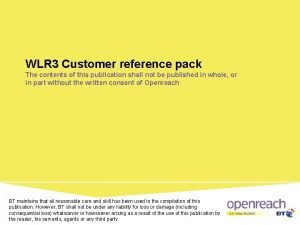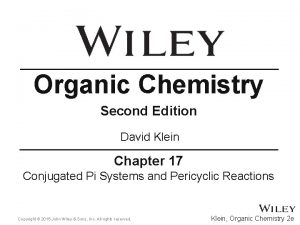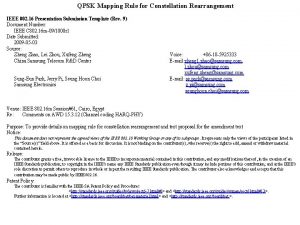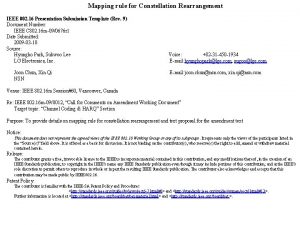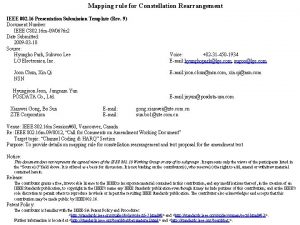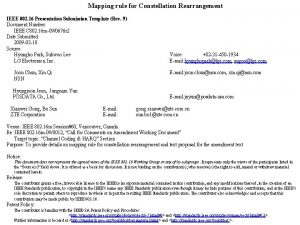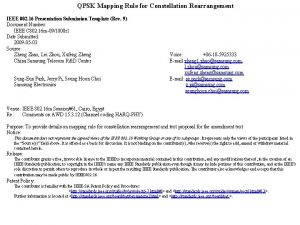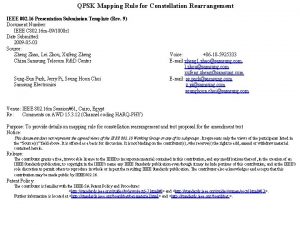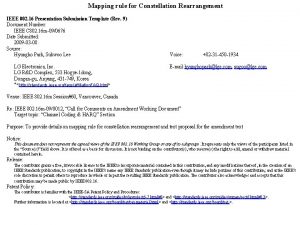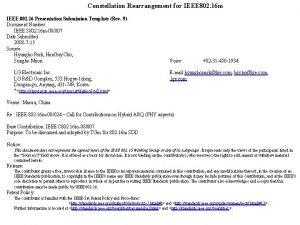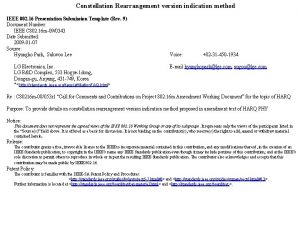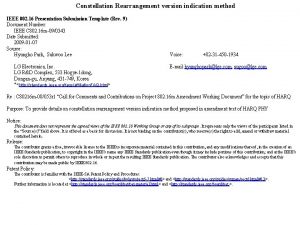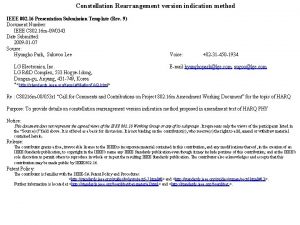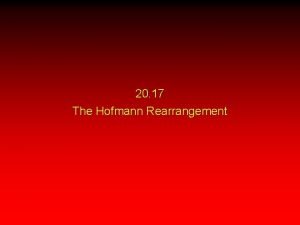Mapping rule for Constellation Rearrangement IEEE 802 16


![Performance gain from bit-swapping between two symbols within a tone [1] • Swapping between Performance gain from bit-swapping between two symbols within a tone [1] • Swapping between](https://slidetodoc.com/presentation_image_h/34c8851a93c85f6ea5b43379431c438e/image-3.jpg)
![Performance gain from bit-swapping between two symbols within a tone [2] • Performance evaluation Performance gain from bit-swapping between two symbols within a tone [2] • Performance evaluation](https://slidetodoc.com/presentation_image_h/34c8851a93c85f6ea5b43379431c438e/image-4.jpg)
![Details of mapping rule for Co. Re version [1] • Mapping rule • Two Details of mapping rule for Co. Re version [1] • Mapping rule • Two](https://slidetodoc.com/presentation_image_h/34c8851a93c85f6ea5b43379431c438e/image-5.jpg)
![Details of mapping rule for Co. Re version [2] • Mapping operation with 2 Details of mapping rule for Co. Re version [2] • Mapping operation with 2](https://slidetodoc.com/presentation_image_h/34c8851a93c85f6ea5b43379431c438e/image-6.jpg)
![Details of mapping rule for Co. Re version [3] • Clean separation from MIMO Details of mapping rule for Co. Re version [3] • Clean separation from MIMO](https://slidetodoc.com/presentation_image_h/34c8851a93c85f6ea5b43379431c438e/image-7.jpg)
![Performance evaluation [1] • Simulation Parameters Assumption Bandwidth 10 MHz Number of subcarrier 1024 Performance evaluation [1] • Simulation Parameters Assumption Bandwidth 10 MHz Number of subcarrier 1024](https://slidetodoc.com/presentation_image_h/34c8851a93c85f6ea5b43379431c438e/image-8.jpg)
![Performance evaluation [2] – Chase HARQ 0. 2 d. B gain over 16 e Performance evaluation [2] – Chase HARQ 0. 2 d. B gain over 16 e](https://slidetodoc.com/presentation_image_h/34c8851a93c85f6ea5b43379431c438e/image-9.jpg)
![Performance evaluation [3] – Chase HARQ 2. 6 d. B gain over 16 e Performance evaluation [3] – Chase HARQ 2. 6 d. B gain over 16 e](https://slidetodoc.com/presentation_image_h/34c8851a93c85f6ea5b43379431c438e/image-10.jpg)
![Performance evaluation [4] – Chase HARQ 4. 7 d. B gain over 16 e Performance evaluation [4] – Chase HARQ 4. 7 d. B gain over 16 e](https://slidetodoc.com/presentation_image_h/34c8851a93c85f6ea5b43379431c438e/image-11.jpg)
![Performance evaluation [5] – IR-HARQ 1. 0 d. B (Max. Tx 2) & 1. Performance evaluation [5] – IR-HARQ 1. 0 d. B (Max. Tx 2) & 1.](https://slidetodoc.com/presentation_image_h/34c8851a93c85f6ea5b43379431c438e/image-12.jpg)
![Performance evaluation [6] – IR-HARQ 1. 2 d. B (Max. Tx 2) & 0. Performance evaluation [6] – IR-HARQ 1. 2 d. B (Max. Tx 2) & 0.](https://slidetodoc.com/presentation_image_h/34c8851a93c85f6ea5b43379431c438e/image-13.jpg)
![Performance evaluation [7] – IR-HARQ 3. 1 d. B (Max. Tx 2) & 4. Performance evaluation [7] – IR-HARQ 3. 1 d. B (Max. Tx 2) & 4.](https://slidetodoc.com/presentation_image_h/34c8851a93c85f6ea5b43379431c438e/image-14.jpg)
![Performance evaluation [8] – IR-HARQ 3. 3 d. B (Max. Tx 2) & 4. Performance evaluation [8] – IR-HARQ 3. 3 d. B (Max. Tx 2) & 4.](https://slidetodoc.com/presentation_image_h/34c8851a93c85f6ea5b43379431c438e/image-15.jpg)

- Slides: 16

Mapping rule for Constellation Rearrangement IEEE 802. 16 Presentation Submission Template (Rev. 9) Document Number: IEEE C 802. 16 m-09/0676 r 1 Date Submitted: 2009 -03 -10 Source: Hyungho Park, Sukwoo Lee LG Electronics, Inc. Joon Chun, Xin Qi NSN Voice: +82 -31 -450 -1934 E-mail: hyunghopark@lge. com, sugoo@lge. com E-mail: joon. chun@nsn. com, xin. qi@nsn. com Venue: IEEE 802. 16 m Session#60, Vancouver, Canada Re: IEEE 802. 16 m-09/0012, “Call for Comments on Amendment Working Document” Target topic: “Channel Coding & HARQ” Section Purpose: To provide details on mapping rule for constellation rearrangement and text proposal for the amendment text Notice: This document does not represent the agreed views of the IEEE 802. 16 Working Group or any of its subgroups. It represents only the views of the participants listed in the “Source(s)” field above. It is offered as a basis for discussion. It is not binding on the contributor(s), who reserve(s) the right to add, amend or withdraw material contained herein. Release: The contributor grants a free, irrevocable license to the IEEE to incorporate material contained in this contribution, and any modifications thereof, in the creation of an IEEE Standards publication; to copyright in the IEEE’s name any IEEE Standards publication even though it may include portions of this contribution; and at the IEEE’s sole discretion to permit others to reproduce in whole or in part the resulting IEEE Standards publication. The contributor also acknowledges and accepts that this contribution may be made public by IEEE 802. 16. Patent Policy: The contributor is familiar with the IEEE-SA Patent Policy and Procedures: <http: //standards. ieee. org/guides/bylaws/sect 6 -7. html#6> and <http: //standards. ieee. org/guides/opman/sect 6. html#6. 3>. Further information is located at <http: //standards. ieee. org/board/pat-material. html> and <http: //standards. ieee. org/board/pat >.

Co. Re version design • Design method for Constellation Rearrangement version – Co. Re related descriptions in current SDD text “ The Co. Re can be expressed by a bit-level interleaver within a tone. ” – Co. Re version should be designed with consideration of bit-level interleaver within a symbol and across symbols within a tone. • Bit-level interleaving within a QAM symbol : averaging out bit reliability difference between component bits within a symbol (swapping MSB with LSB) • Bit-level interleaving of inter-symbols within a tone: to exploit spatial diversity gain – The starting position is determined as SPID function in unit of 2 QAM symbols
![Performance gain from bitswapping between two symbols within a tone 1 Swapping between Performance gain from bit-swapping between two symbols within a tone [1] • Swapping between](https://slidetodoc.com/presentation_image_h/34c8851a93c85f6ea5b43379431c438e/image-3.jpg)
Performance gain from bit-swapping between two symbols within a tone [1] • Swapping between two symbols within a tone • 16 QAM – – – 64 QAM Simulation assumption: ½ CTC, VEHA 30 km/h, MMSE receiver. 2 x 2 SM, distributed LRU, Max Tx: 2 In simulation results, legend N bit (I: A, Q: B) means that A-bit of In-phase part and B-bit of Quadrature-phase part are swapped between two symbols within a tone to exploit extra spatial gain. From simulation results, we can know that bitwise swapping has better performance than symbol-wise swapping.
![Performance gain from bitswapping between two symbols within a tone 2 Performance evaluation Performance gain from bit-swapping between two symbols within a tone [2] • Performance evaluation](https://slidetodoc.com/presentation_image_h/34c8851a93c85f6ea5b43379431c438e/image-4.jpg)
Performance gain from bit-swapping between two symbols within a tone [2] • Performance evaluation in HARQ retransmission – Bit interleaving within a QAM symbol is excluded to survey on the impact of spatial mapping with increased retransmission number (vertical mapping) mapping rule applied in simulation Co. Re version (CRV) Mapping rule (64 QAM) Symbol 1 Symbol 2 0 1 – In case of 64 QAM, it’s the best mapping rule that SB of first spatial stream is swapped with SB of second spatial stream in the aspect of performance and complexity.
![Details of mapping rule for Co Re version 1 Mapping rule Two Details of mapping rule for Co. Re version [1] • Mapping rule • Two](https://slidetodoc.com/presentation_image_h/34c8851a93c85f6ea5b43379431c438e/image-5.jpg)
Details of mapping rule for Co. Re version [1] • Mapping rule • Two Co. Re versions • Rank 1 • Rank 2 or more • Proposed mapping rules are designed in the aspect of average performance gain for maximum retransmission. • Proposed mapping rule is enabled to deploy with low implementation complexity.
![Details of mapping rule for Co Re version 2 Mapping operation with 2 Details of mapping rule for Co. Re version [2] • Mapping operation with 2](https://slidetodoc.com/presentation_image_h/34c8851a93c85f6ea5b43379431c438e/image-6.jpg)
Details of mapping rule for Co. Re version [2] • Mapping operation with 2 Co. Re versions in retransmission • 16 QAM • 64 QAM
![Details of mapping rule for Co Re version 3 Clean separation from MIMO Details of mapping rule for Co. Re version [3] • Clean separation from MIMO](https://slidetodoc.com/presentation_image_h/34c8851a93c85f6ea5b43379431c438e/image-7.jpg)
Details of mapping rule for Co. Re version [3] • Clean separation from MIMO configuration - After bit-interleaving of two symbols within a tone, the resulted symbols are fed to time-frequency resource - Regardless of the number of rank, Co. Re is applied in a unit of two symbols within a tone. Paired two symbols with Co. Re are mapped to time-frequency resource unit without any impact to the corresponding MIMO modes
![Performance evaluation 1 Simulation Parameters Assumption Bandwidth 10 MHz Number of subcarrier 1024 Performance evaluation [1] • Simulation Parameters Assumption Bandwidth 10 MHz Number of subcarrier 1024](https://slidetodoc.com/presentation_image_h/34c8851a93c85f6ea5b43379431c438e/image-8.jpg)
Performance evaluation [1] • Simulation Parameters Assumption Bandwidth 10 MHz Number of subcarrier 1024 Frame length 5 ms Channel estimation Perfect Channel code/HARQ CTC ½ / Chase, IR Modulation QPSK, 16 QAM, 64 QAM MIMO configuration 2 x 2 SM Resource allocation Distributed resource allocation Channel model PEDB, VEH A MS mobility 3 km/h, 120 km/h Receiver type Linear MMSE Maximum number of retransmission 1~4 Retransmission latency 10 ms
![Performance evaluation 2 Chase HARQ 0 2 d B gain over 16 e Performance evaluation [2] – Chase HARQ 0. 2 d. B gain over 16 e](https://slidetodoc.com/presentation_image_h/34c8851a93c85f6ea5b43379431c438e/image-9.jpg)
Performance evaluation [2] – Chase HARQ 0. 2 d. B gain over 16 e @ 10% FER
![Performance evaluation 3 Chase HARQ 2 6 d B gain over 16 e Performance evaluation [3] – Chase HARQ 2. 6 d. B gain over 16 e](https://slidetodoc.com/presentation_image_h/34c8851a93c85f6ea5b43379431c438e/image-10.jpg)
Performance evaluation [3] – Chase HARQ 2. 6 d. B gain over 16 e @ 10% FER
![Performance evaluation 4 Chase HARQ 4 7 d B gain over 16 e Performance evaluation [4] – Chase HARQ 4. 7 d. B gain over 16 e](https://slidetodoc.com/presentation_image_h/34c8851a93c85f6ea5b43379431c438e/image-11.jpg)
Performance evaluation [4] – Chase HARQ 4. 7 d. B gain over 16 e @ 10% FER
![Performance evaluation 5 IRHARQ 1 0 d B Max Tx 2 1 Performance evaluation [5] – IR-HARQ 1. 0 d. B (Max. Tx 2) & 1.](https://slidetodoc.com/presentation_image_h/34c8851a93c85f6ea5b43379431c438e/image-12.jpg)
Performance evaluation [5] – IR-HARQ 1. 0 d. B (Max. Tx 2) & 1. 3 d. B (Max. Tx 4) gain over 16 e @ 10% FER
![Performance evaluation 6 IRHARQ 1 2 d B Max Tx 2 0 Performance evaluation [6] – IR-HARQ 1. 2 d. B (Max. Tx 2) & 0.](https://slidetodoc.com/presentation_image_h/34c8851a93c85f6ea5b43379431c438e/image-13.jpg)
Performance evaluation [6] – IR-HARQ 1. 2 d. B (Max. Tx 2) & 0. 8 d. B (Max. Tx 4) gain over 16 e @ 10% FER
![Performance evaluation 7 IRHARQ 3 1 d B Max Tx 2 4 Performance evaluation [7] – IR-HARQ 3. 1 d. B (Max. Tx 2) & 4.](https://slidetodoc.com/presentation_image_h/34c8851a93c85f6ea5b43379431c438e/image-14.jpg)
Performance evaluation [7] – IR-HARQ 3. 1 d. B (Max. Tx 2) & 4. 2 d. B (Max. Tx 4) gain over 16 e @ 10% FER
![Performance evaluation 8 IRHARQ 3 3 d B Max Tx 2 4 Performance evaluation [8] – IR-HARQ 3. 3 d. B (Max. Tx 2) & 4.](https://slidetodoc.com/presentation_image_h/34c8851a93c85f6ea5b43379431c438e/image-15.jpg)
Performance evaluation [8] – IR-HARQ 3. 3 d. B (Max. Tx 2) & 4. 2 d. B (Max. Tx 4) gain over 16 e @ 10% FER

Conclusion • Adopt the following text proposal including mapping rule with 2 Co. Re versions into Section 15. x. 2. 2. (Constellation Rearrangement) of the Amendment text as in IEEE 802. 16 m-09/0010
 Bridges from 802.x to 802.y
Bridges from 802.x to 802.y Bridges from 802.x to 802.y
Bridges from 802.x to 802.y Obtuse angle rule
Obtuse angle rule 802 15
802 15 802 ieee
802 ieee Ieee 802
Ieee 802 Ieee 802 family
Ieee 802 family Ieee 802 3 compliance
Ieee 802 3 compliance Wlan standards
Wlan standards Arquitetura ieee 802
Arquitetura ieee 802 El 802
El 802 Ieee 802 standard
Ieee 802 standard Rule constellation
Rule constellation Semipinacol rearrangement
Semipinacol rearrangement Feedback inhibitor
Feedback inhibitor Openreach line plant rearrangement
Openreach line plant rearrangement Diels alder reaction
Diels alder reaction












